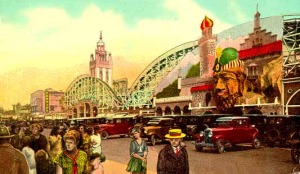 Coney Island is a peninsular residential neighborhood, beach, and leisure/entertainment destination on the Atlantic Ocean in the southwestern part of the borough of Brooklyn, New York City. The site was formerly an outer barrier island, but became partially connected to the mainland by landfill. The residential portion of the peninsula is a community of 60,000 people in its western part, with Sea Gate to its west, Brighton Beach and Manhattan Beach to its east, the Atlantic Ocean to the south, and Gravesend to the north.
Coney Island is a peninsular residential neighborhood, beach, and leisure/entertainment destination on the Atlantic Ocean in the southwestern part of the borough of Brooklyn, New York City. The site was formerly an outer barrier island, but became partially connected to the mainland by landfill. The residential portion of the peninsula is a community of 60,000 people in its western part, with Sea Gate to its west, Brighton Beach and Manhattan Beach to its east, the Atlantic Ocean to the south, and Gravesend to the north.
Coney Island is well known as the site of amusement parks and a seaside resort. The attractions reached a historical peak during the first half of the 20th century, declining in popularity after World War II and years of neglect. In recent years, the area has seen the opening of MCU Park stadium and has become home to the Brooklyn Cyclones minor league baseball team, as well as the opening of a new amusement park among several adjacent ones.
Development on Coney Island has always been controversial. When the first structures were built around the 1840s, there was an outcry to prevent any development on the island and preserve it as a natural park. Starting in the early 1900s, the City of New York made efforts to condemn all buildings and piers built south of Surf Avenue. It was an effort to reclaim the beach which by then had almost completely been built over with bath houses, clam bars, amusements, and other structures. The local amusement community opposed the city. Eventually a settlement was reached where the beach did not begin until 1,000 feet south of Surf Avenue, the territory marked by a city-owned boardwalk, while the city would demolish any structures that had been built over public streets, to reclaim beach access.
Between about 1880 and World War II, Coney Island was the largest amusement area in the United States, attracting several million visitors per year. At its height it contained three competing major amusement parks, Luna Park, Dreamland, and Steeplechase Park, as well as many independent amusements.
Due to Coney Island’s being easily reached from Manhattan and other boroughs yet distant enough from the city of Brooklyn to provide the illusion of a proper vacation, it began attracting vacationers in the 1830s and 1840s, assisted by carriage roads and steamship service that reduced travel time from a formerly half-day journey to two hours. The construction of the Coney Island Hotel in 1829. The Brighton, Manhattan Beach, and Oriental Hotels would open shortly afterward.
Coney Island became a major resort destination after the Civil War as excursion railroads and the Coney Island & Brooklyn Railroad streetcar line reached the area in the 1860s, and the Iron steamboat company in 1881. When the Brooklyn Rapid Transit Company electrified the steam railroads and connected Brooklyn to Manhattan via the Brooklyn Bridge at the beginning of the 20th century, Coney Island turned rapidly from a resort to an accessible location for day-trippers seeking to escape the summer heat in New York City’s tenements.
Charles I. D. Looff, a Danish woodcarver, built the first carousel at Coney Island in 1876. It was installed at Vandeveer’s bath-house complex at West 6th Street and Surf Avenue. The complex was later called Balmer’s Pavilion. The carousel consisted of hand-carved horses and animals standing two abreast. Two musicians, a drummer and a flute player, provided the music. A metal ring-arm hung on a pole outside the ride, feeding small, iron rings for eager riders to grab. A tent-top protected the riders from the weather. The fare was five cents.
From 1885 to 1896, the Coney Island Elephant was the first sight to greet immigrants arriving in New York, who would see it before they saw the Statue of Liberty.
In 1915 the Sea Beach Line was upgraded to a subway line, followed by the other former excursion roads, and the opening of the New West End Terminal in 1919 ushered in Coney Island’s busiest era.
After World War II, contraction began seriously from a series of pressures. Air conditioning in movie theaters and then in homes, along with the advent of automobiles, which provided access to the less crowded and more appealing Long Island state parks, especially Jones Beach, lessened the attractions of Coney’s beaches. Luna Park closed in 1946 after a series of fires and the street gang problems of the 1950s spilled into Coney Island. The presence of threatening youths did not impact the beachgoing but discouraged visitors to the rides and concessions, staples of the Coney Island economy. The local economy was particularly impacted by the 1964 closing of Steeplechase Park.
Source: Wikipedia






